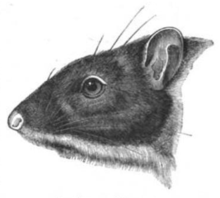Megalomys desmarestii
It was among the largest species of West Indian rice rats, as big as a cat, and was one of the first Caribbean mammals to become extinct during the 20th century.[2] It may have been semi-aquatic, as it was known to escape into the sea when pursued by predators, but it never swam away from the island.[4] It was common on Martinique until the end of the 19th century, when attempts were made to exterminate it because it was considered to be a pest of the island's coconut plantations.It was also hunted for food; however, due to its strong musky odor, this was uncommon.On 8 May 1902, the volcano Mount Pelée erupted, completely destroying the island's principal city of Saint-Pierre.
Conservation statusExtinctIUCN 3.1Scientific classificationEukaryotaAnimaliaChordataMammaliaRodentiaCricetidaeSigmodontinaeMegalomysBinomial nameJ. Fischerrice ratMartiniqueCaribbeancoconutvolcanoMount PeléeSaint-Pierreintroducedsmall Indian mongoosesIUCN Red List of Threatened SpeciesOryzomyini (rice rats)AegialomysA. galapagoensisA. xanthaeolusAgathaeromysA. donovaniA. praeuniversitatisAmphinectomysA. savamisCarletonomysC. cailoiCerradomysC. goytacaC. langguthiC. maracajuensisC. marinhusC. scottiC. subflavusC. vivoiDrymoreomysD. albimaculatusEremoryzomysE. poliusEuryoryzomysE. emmonsaeE. lamiaE. legatusE. macconnelliE. nitidusE. russatusHandleyomysH. alfaroiH. chapmaniH. fuscatusH. intectusH. melanotisH. rhabdopsH. rostratusH. saturatiorHolochilusH. brasiliensisH. chacariusH. sciureusHylaeamysH. acritusH. laticepsH. megacephalusH. oniscusH. perenensisH. tateiH. yunganusLundomysL. molitorM. audreyaeM. curazensisM. georginaeM. luciaeMelanomysM. caliginosusM. robustulusM. zunigaeMicroakodontomysM. transitoriusMicroryzomysM. altissimusM. minutusMindomysM. hammondiNeacomysN. dubostiN. guianaeN. minutusN. musseriN. paracouN. pictusN. spinosusN. tenuipesNectomysN. apicalisN. grandisN. palmipesN. rattusN. squamipesNephelomysN. albigularisN. auriventerN. caracolusN. childiN. deviusN. keaysiN. levipesN. maculiventerN. meridensisN. moerexN. nimbosusN. pectoralisN. pirrensisNesoryzomysN. darwiniN. indefessusN. fernandinaeN. narboroughi